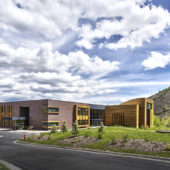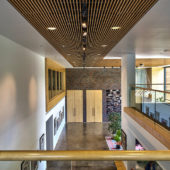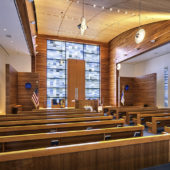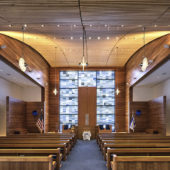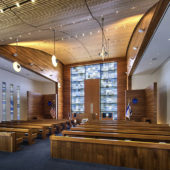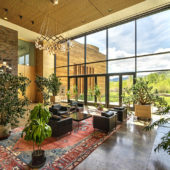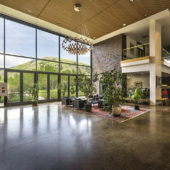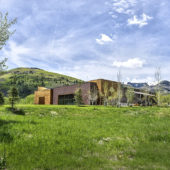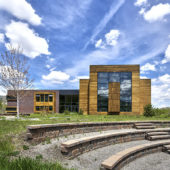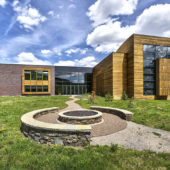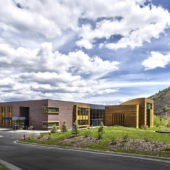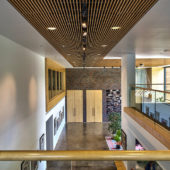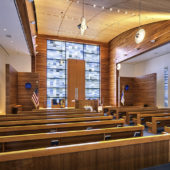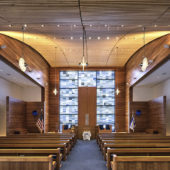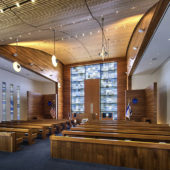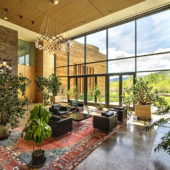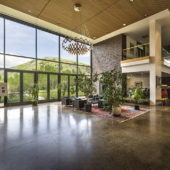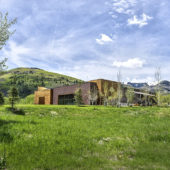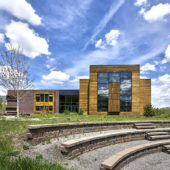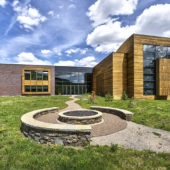Known as the ski shul, the synagogue looks to the future rather than historical antecedents.
The area that is now Park City, Utah is in a high mountain canyon 32 miles southeast of downtown Salt Lake City. Early Mormon pioneers traversed and explored the area on their way to settle Salt Lake City. Discovery of gold, silver and lead ore in the area lead to a large mining boom. In 1892 the Silver King Mine became one of the most famous silver mines in the world. The town flourished with crowds of miners and wealth. However, the city nearly became a ghost town by the end of the 1950s because of a drop in the price of silver.
Park City’s fortunes changed for the better when it became a world–class skiing resort in the latter half of the 20th century. In 1995 Temple Har Shalom was established as a home for the Jewish community. The congregation affiliated with the Reform Movement in 1999 and with the engagement of a full–time rabbi in 2002 weekly religious services were established.
Literally meaning Mountain of Peace, choice of the name Har Shalom was influenced by its 7,000 foot high location nestled among mountains. Known as the Ski Shul, Har Shalom combines the design of German–born synagogue architect Alfred Jacoby, the glass artistry of Japanese–born glass Jun Kaneko and a love for Jewish learning, tradition and skiing.
Alfred Jacoby, a noted German architect and professor at the Bauhaus School, said his “approach to synagogue design focuses on the future and potential of a Jewish community rather than look to past architectural influences.” Jacoby designed a building that at once is accessible, elegant yet non–confrontational blending with its surroundings with high ceilings, expansive views of the mountains and an abundant use of native wood.
“The building tries at all points to connect to the outside very much and give you an impression of a connection between you and that shelter and nature,” Jacoby said. “It’s a place for spirituality and it is also a space for identity where Jews can congregate and have festivals and to really have joy in that building.”
The sanctuary windows were created by Jun Kaneko who said “”This was my first big architecturally integrated window, so I studied quite a bit about the space and the relationship of natural light coming through the inside of the windows and outside. The temple members in Park City had to teach me what is important about Judaism. Very early I had an idea about using lot of color, but because people come together at the Temple with a purpose, color would be distracting. I picked blue and white as the major colors because those are spiritual and mysterious colors to me and it just happens to be the colors of the flag of Israel.”
According to the congregation’s first rabbi, “The windows have been likened to a tallis – the Jewish prayer shawl – that wraps around the ark which holds the Torah, Judaism’s most sacred text, while the 12 stained glass windows on either side of the sanctuary are like the fringes of the tallis, enveloping the congregation in spirituality, warmth, and community.”
During the ski season the rabbi leads a Friday afternoon ski run starting at the top of Deer Valley Ski Area, culminating with a Shabbat service and oneg. In January the synagogue’s social hall becomes “The Temple Theater” where documentary films are screened for the famous Sundance Film Festival which takes place in the valley.

